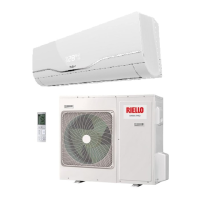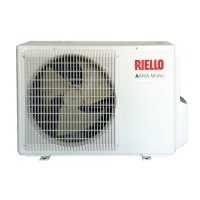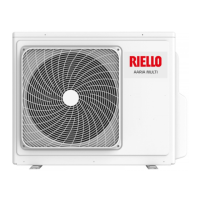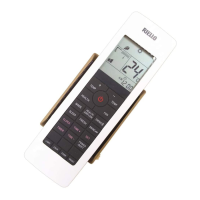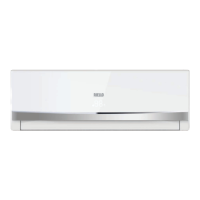Do you have a question about the Riello AARIA PRO P 1070 M and is the answer not in the manual?
Key initial checks, notifications, and product handling guidelines.
Essential safety rules for operation, handling, and electrical safety.
Overview of the heat pump unit's features, control systems, and refrigerant.
Details on built-in safety mechanisms like thermal protection and sensors.
How to identify the unit via its technical data plate and serial number.
Diagrams illustrating components for different models (1070 M to 1140 T).
Performance data, energy efficiency ratings, and specifications for combined units.
Required space around the unit for installation and ventilation.
Temperature ranges for cooling and heating modes for optimal performance.
Explanation of the heat pump's refrigerant circuit and its cycle.
Procedures for checking the unit and its included materials upon delivery.
Correct placement of package and transport labels for identification.
Physical size and weight specifications for each model.
Guidelines for storing the unit safely before installation.
Safe methods for unpacking and handling the unit with care.
Criteria for selecting an appropriate outdoor installation location.
Minimum clearances required around the unit for airflow and maintenance.
Instructions for correctly positioning the unit on the floor or suspended.
Considerations for integrating the unit with existing systems.
Detailed steps for connecting refrigerant lines, including pipe insulation and valves.
Electrical schematics for connecting the unit's internal components and power.
Procedures for connecting the unit to the electrical power grid and indoor unit.
Pre-operation checks for safety, connections, and power supply.
Procedure for adding refrigerant based on pipe length and model.
Steps to activate the unit and perform initial checks after setup.
Routine checks, cleaning, and recommended service intervals.
Understanding unit status indicators, LEDs, and fault codes for troubleshooting.
Key initial checks, notifications, and product handling guidelines.
Essential safety rules for operation, handling, and electrical safety.
Overview of the heat pump unit's features, control systems, and refrigerant.
Details on built-in safety mechanisms like thermal protection and sensors.
How to identify the unit via its technical data plate and serial number.
Diagrams illustrating components for different models (1070 M to 1140 T).
Performance data, energy efficiency ratings, and specifications for combined units.
Required space around the unit for installation and ventilation.
Temperature ranges for cooling and heating modes for optimal performance.
Explanation of the heat pump's refrigerant circuit and its cycle.
Procedures for checking the unit and its included materials upon delivery.
Correct placement of package and transport labels for identification.
Physical size and weight specifications for each model.
Guidelines for storing the unit safely before installation.
Safe methods for unpacking and handling the unit with care.
Criteria for selecting an appropriate outdoor installation location.
Minimum clearances required around the unit for airflow and maintenance.
Instructions for correctly positioning the unit on the floor or suspended.
Considerations for integrating the unit with existing systems.
Detailed steps for connecting refrigerant lines, including pipe insulation and valves.
Electrical schematics for connecting the unit's internal components and power.
Procedures for connecting the unit to the electrical power grid and indoor unit.
Pre-operation checks for safety, connections, and power supply.
Procedure for adding refrigerant based on pipe length and model.
Steps to activate the unit and perform initial checks after setup.
Routine checks, cleaning, and recommended service intervals.
Understanding unit status indicators, LEDs, and fault codes for troubleshooting.
| Cooling capacity | 2.64 kW |
|---|---|
| Energy efficiency class cooling | A |
| Sound power level | 65 dB(A) |
| Refrigerant | R410A |
| Power Supply | 220-240 V, 50 Hz |
